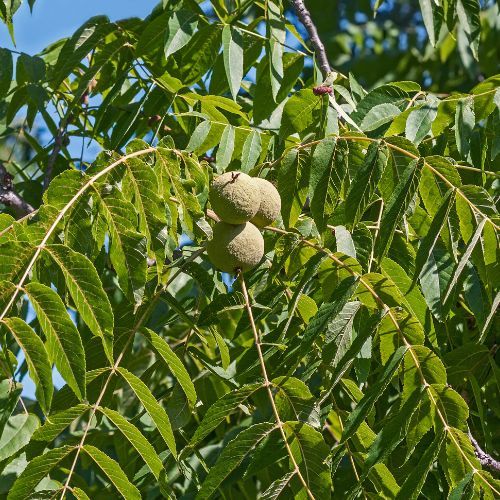Position
Plant your walnut tree in full sun or a spot with at least 6 to 8 hours of sunlight daily. Make sure it has plenty of space as it will grow into a huge tree and will be difficult to transplant, even 1 or 2 years later.
Size
These trees grow to a height of between 30 and 40 metres tall with a canopy spread of 18 metres.
Soil
Walnut trees require well-drained, fertile soil like sandy loam. Clay is not advisable. They require slightly acidic soil, so they benefit from a bag of our blueberry mix or half a bag of acid compost. Dig a large hole by breaking up the soil and adding plenty of well-rotted organic matter. A wide hole is better than a very deep one.
Nut trees require fertile soil for good growth. So, before you plant it, add some nutrients to your soil, like volcanic rock dust and good quality organic compost. Water the soil thoroughly before planting, and be careful not to bend the roots.
Fertiliser
Apply 1 teaspoon of our slow-release nitrogen-rich berry fertiliser every 4-5 months.
Mulch
Add a thick layer of pine bark mulch, keeping it about 20 to 30 centimetres away from the tree trunk (any closer may cause excess moisture and damage the trunk). This will retain the moisture in the soil and will prevent weeds from taking over.
Pests and Diseases
Aphids, citrus psylla, red scale, citrus greening. Spraying regularly with Agricultural Neem Oil or Effective Microorganisms (EM Control ) will assist in either prevention or after the fact. If you already have aphids or mites, wash the tree with a harsh hosing, and when dry, spray with Neem oil or EM Control.
Practice good garden hygiene (remove fallen fruit and leaves).
Watch for root rot (if overwatered) and fungal infections during wet periods.
Watering
Never use a sprinkler and avoid splashing water onto the leaves as this will promote the development of walnut blight. Water the tree well every second week once established, as they become stressed if over-watered.
Pruning
While the tree is dormant, cut off the dry and dead branches. If any branches are crossing, then remove one. You can also remove new shoots in the middle of the tree to ensure maximum light and air penetration.
Frost
Your walnut tree is frost-tolerant, but flowers could get damaged with a late frost.
Harvesting
Walnuts fall from the tree when they are ripe. Be sure to collect them quickly to prevent them from moulding on the ground.









